PUBH6005: Community & Primary Care Education Impact on Antibiotics
VerifiedAdded on 2023/05/28
|15
|4420
|50
Essay
AI Summary
This essay critically appraises the effectiveness of community and primary care education interventions in reducing antibiotic prescription rates. It examines relevant literature, focusing on studies that investigate the impact of educational programs on antibiotic use for respiratory infections. The analysis includes a review of randomized controlled trials (RCTs) conducted in various settings, such as Singapore and Scotland, assessing the methodological rigor and potential biases in each study. The essay evaluates the study designs, sample representativeness, and ethical considerations, utilizing tools like the CASP checklist to determine the validity and reliability of the findings. Ultimately, the essay aims to provide insights into the role of community and primary care education in combating antimicrobial resistance and promoting responsible antibiotic usage. Desklib provides access to similar solved assignments and study tools for students.
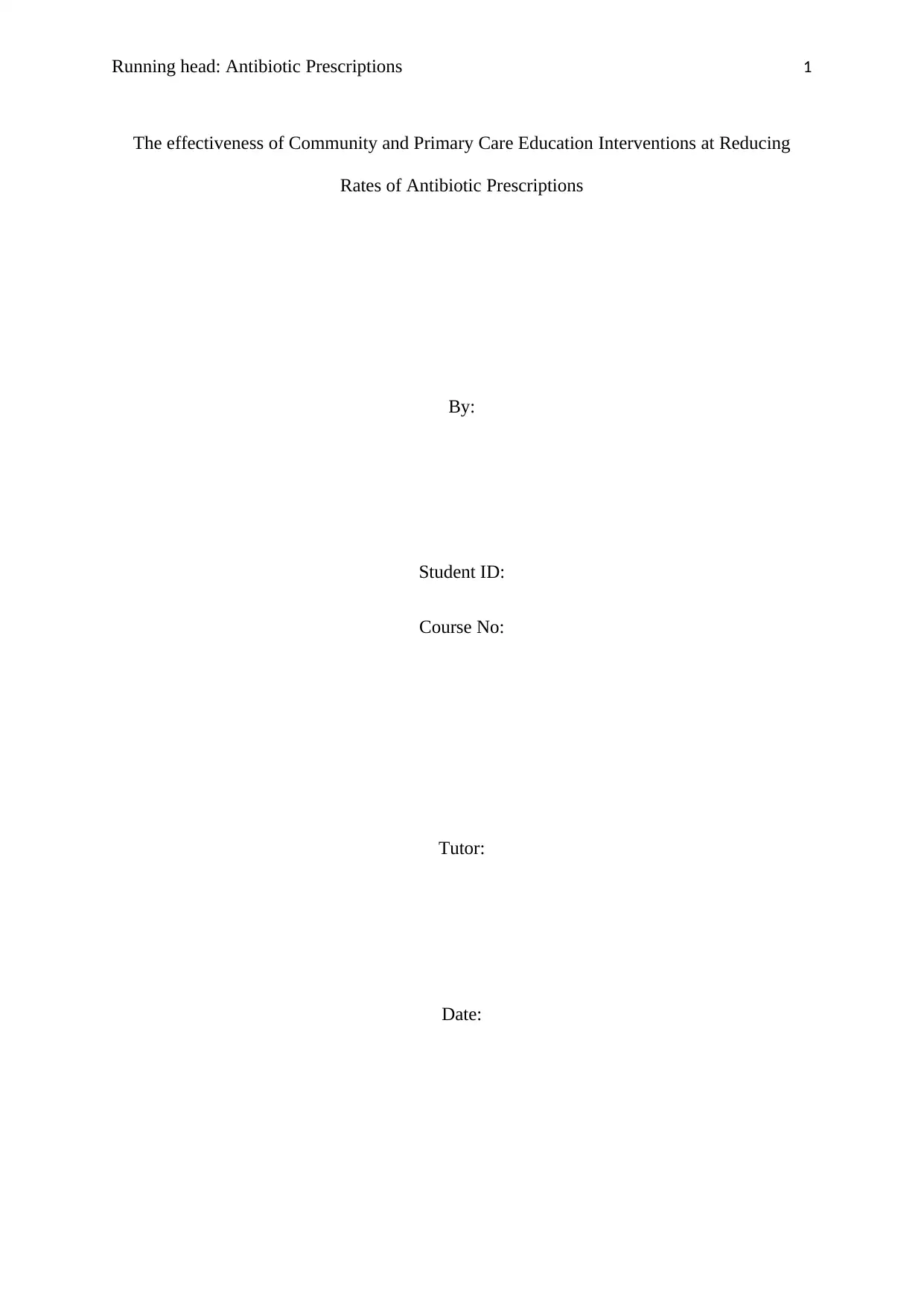
Running head: Antibiotic Prescriptions 1
The effectiveness of Community and Primary Care Education Interventions at Reducing
Rates of Antibiotic Prescriptions
By:
Student ID:
Course No:
Tutor:
Date:
The effectiveness of Community and Primary Care Education Interventions at Reducing
Rates of Antibiotic Prescriptions
By:
Student ID:
Course No:
Tutor:
Date:
Paraphrase This Document
Need a fresh take? Get an instant paraphrase of this document with our AI Paraphraser
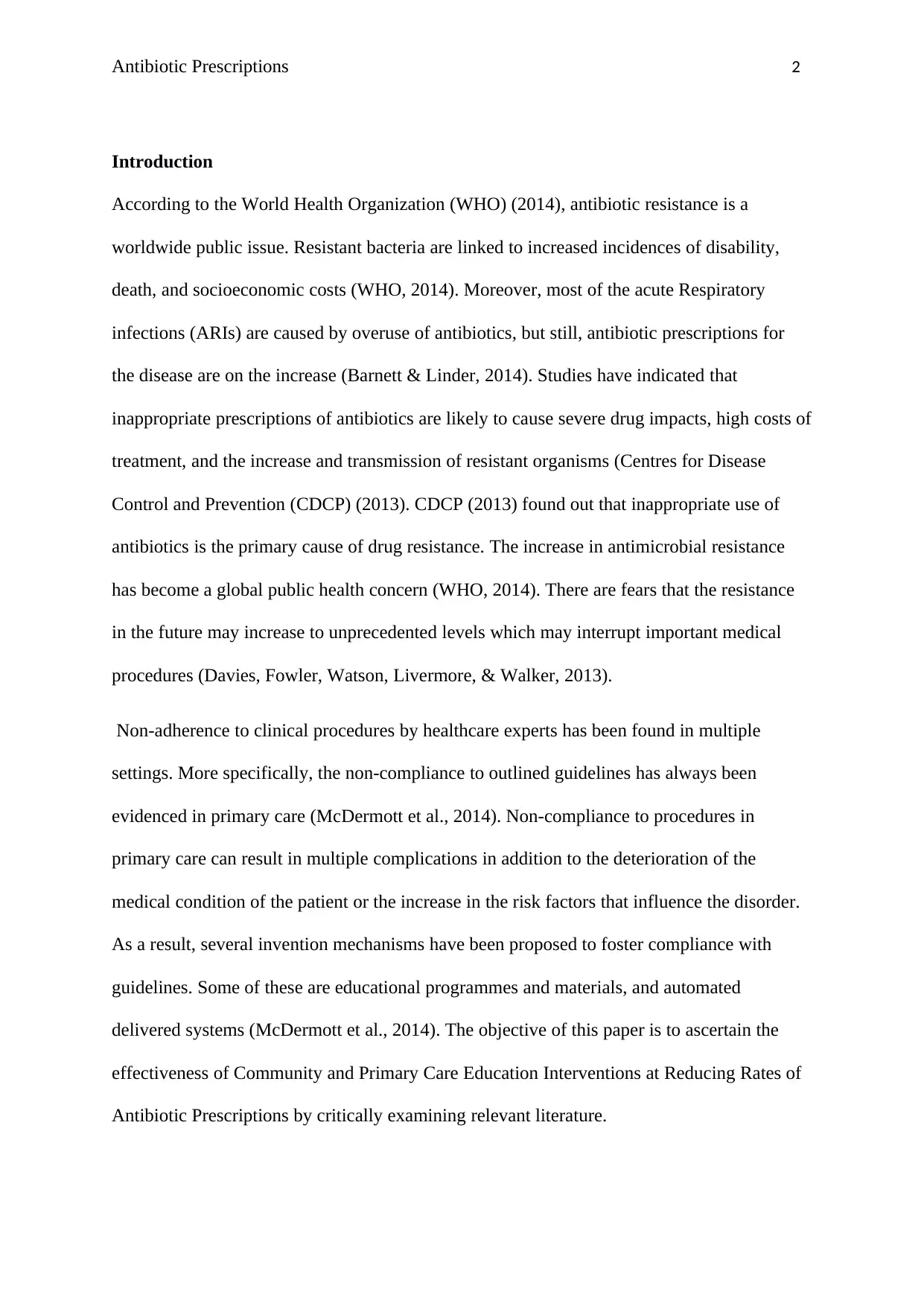
Antibiotic Prescriptions 2
Introduction
According to the World Health Organization (WHO) (2014), antibiotic resistance is a
worldwide public issue. Resistant bacteria are linked to increased incidences of disability,
death, and socioeconomic costs (WHO, 2014). Moreover, most of the acute Respiratory
infections (ARIs) are caused by overuse of antibiotics, but still, antibiotic prescriptions for
the disease are on the increase (Barnett & Linder, 2014). Studies have indicated that
inappropriate prescriptions of antibiotics are likely to cause severe drug impacts, high costs of
treatment, and the increase and transmission of resistant organisms (Centres for Disease
Control and Prevention (CDCP) (2013). CDCP (2013) found out that inappropriate use of
antibiotics is the primary cause of drug resistance. The increase in antimicrobial resistance
has become a global public health concern (WHO, 2014). There are fears that the resistance
in the future may increase to unprecedented levels which may interrupt important medical
procedures (Davies, Fowler, Watson, Livermore, & Walker, 2013).
Non-adherence to clinical procedures by healthcare experts has been found in multiple
settings. More specifically, the non-compliance to outlined guidelines has always been
evidenced in primary care (McDermott et al., 2014). Non-compliance to procedures in
primary care can result in multiple complications in addition to the deterioration of the
medical condition of the patient or the increase in the risk factors that influence the disorder.
As a result, several invention mechanisms have been proposed to foster compliance with
guidelines. Some of these are educational programmes and materials, and automated
delivered systems (McDermott et al., 2014). The objective of this paper is to ascertain the
effectiveness of Community and Primary Care Education Interventions at Reducing Rates of
Antibiotic Prescriptions by critically examining relevant literature.
Introduction
According to the World Health Organization (WHO) (2014), antibiotic resistance is a
worldwide public issue. Resistant bacteria are linked to increased incidences of disability,
death, and socioeconomic costs (WHO, 2014). Moreover, most of the acute Respiratory
infections (ARIs) are caused by overuse of antibiotics, but still, antibiotic prescriptions for
the disease are on the increase (Barnett & Linder, 2014). Studies have indicated that
inappropriate prescriptions of antibiotics are likely to cause severe drug impacts, high costs of
treatment, and the increase and transmission of resistant organisms (Centres for Disease
Control and Prevention (CDCP) (2013). CDCP (2013) found out that inappropriate use of
antibiotics is the primary cause of drug resistance. The increase in antimicrobial resistance
has become a global public health concern (WHO, 2014). There are fears that the resistance
in the future may increase to unprecedented levels which may interrupt important medical
procedures (Davies, Fowler, Watson, Livermore, & Walker, 2013).
Non-adherence to clinical procedures by healthcare experts has been found in multiple
settings. More specifically, the non-compliance to outlined guidelines has always been
evidenced in primary care (McDermott et al., 2014). Non-compliance to procedures in
primary care can result in multiple complications in addition to the deterioration of the
medical condition of the patient or the increase in the risk factors that influence the disorder.
As a result, several invention mechanisms have been proposed to foster compliance with
guidelines. Some of these are educational programmes and materials, and automated
delivered systems (McDermott et al., 2014). The objective of this paper is to ascertain the
effectiveness of Community and Primary Care Education Interventions at Reducing Rates of
Antibiotic Prescriptions by critically examining relevant literature.
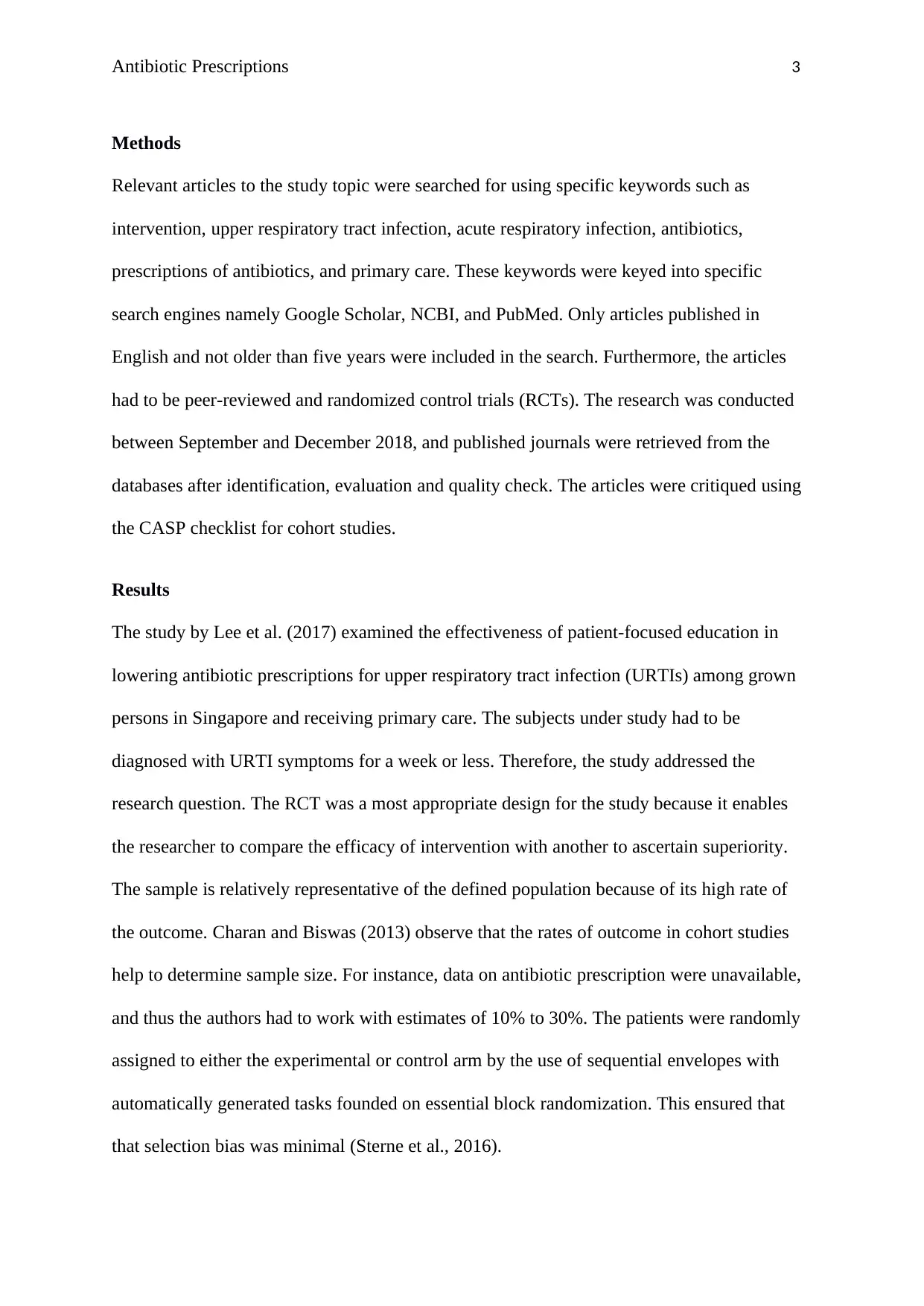
Antibiotic Prescriptions 3
Methods
Relevant articles to the study topic were searched for using specific keywords such as
intervention, upper respiratory tract infection, acute respiratory infection, antibiotics,
prescriptions of antibiotics, and primary care. These keywords were keyed into specific
search engines namely Google Scholar, NCBI, and PubMed. Only articles published in
English and not older than five years were included in the search. Furthermore, the articles
had to be peer-reviewed and randomized control trials (RCTs). The research was conducted
between September and December 2018, and published journals were retrieved from the
databases after identification, evaluation and quality check. The articles were critiqued using
the CASP checklist for cohort studies.
Results
The study by Lee et al. (2017) examined the effectiveness of patient-focused education in
lowering antibiotic prescriptions for upper respiratory tract infection (URTIs) among grown
persons in Singapore and receiving primary care. The subjects under study had to be
diagnosed with URTI symptoms for a week or less. Therefore, the study addressed the
research question. The RCT was a most appropriate design for the study because it enables
the researcher to compare the efficacy of intervention with another to ascertain superiority.
The sample is relatively representative of the defined population because of its high rate of
the outcome. Charan and Biswas (2013) observe that the rates of outcome in cohort studies
help to determine sample size. For instance, data on antibiotic prescription were unavailable,
and thus the authors had to work with estimates of 10% to 30%. The patients were randomly
assigned to either the experimental or control arm by the use of sequential envelopes with
automatically generated tasks founded on essential block randomization. This ensured that
that selection bias was minimal (Sterne et al., 2016).
Methods
Relevant articles to the study topic were searched for using specific keywords such as
intervention, upper respiratory tract infection, acute respiratory infection, antibiotics,
prescriptions of antibiotics, and primary care. These keywords were keyed into specific
search engines namely Google Scholar, NCBI, and PubMed. Only articles published in
English and not older than five years were included in the search. Furthermore, the articles
had to be peer-reviewed and randomized control trials (RCTs). The research was conducted
between September and December 2018, and published journals were retrieved from the
databases after identification, evaluation and quality check. The articles were critiqued using
the CASP checklist for cohort studies.
Results
The study by Lee et al. (2017) examined the effectiveness of patient-focused education in
lowering antibiotic prescriptions for upper respiratory tract infection (URTIs) among grown
persons in Singapore and receiving primary care. The subjects under study had to be
diagnosed with URTI symptoms for a week or less. Therefore, the study addressed the
research question. The RCT was a most appropriate design for the study because it enables
the researcher to compare the efficacy of intervention with another to ascertain superiority.
The sample is relatively representative of the defined population because of its high rate of
the outcome. Charan and Biswas (2013) observe that the rates of outcome in cohort studies
help to determine sample size. For instance, data on antibiotic prescription were unavailable,
and thus the authors had to work with estimates of 10% to 30%. The patients were randomly
assigned to either the experimental or control arm by the use of sequential envelopes with
automatically generated tasks founded on essential block randomization. This ensured that
that selection bias was minimal (Sterne et al., 2016).
⊘ This is a preview!⊘
Do you want full access?
Subscribe today to unlock all pages.

Trusted by 1+ million students worldwide
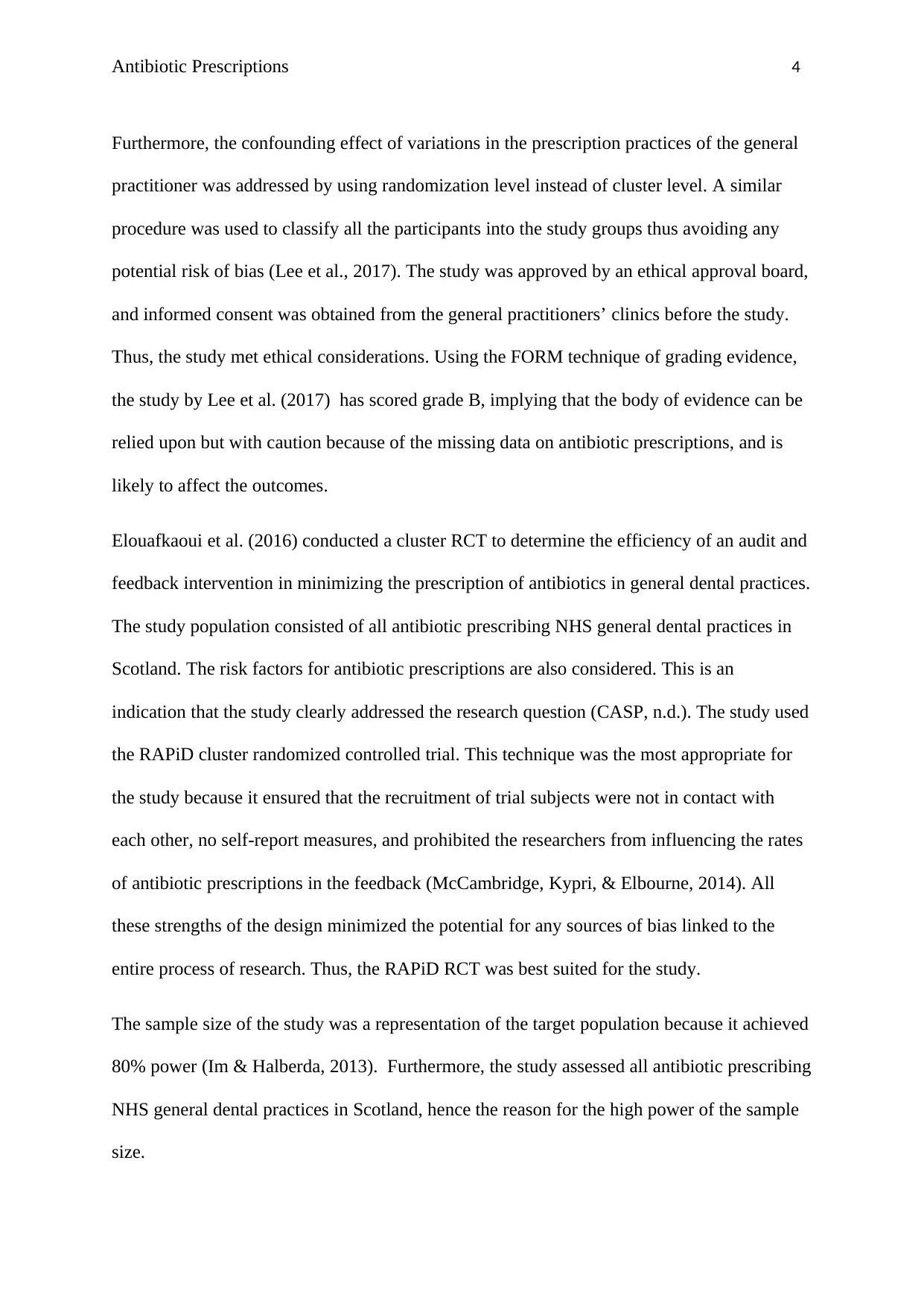
Antibiotic Prescriptions 4
Furthermore, the confounding effect of variations in the prescription practices of the general
practitioner was addressed by using randomization level instead of cluster level. A similar
procedure was used to classify all the participants into the study groups thus avoiding any
potential risk of bias (Lee et al., 2017). The study was approved by an ethical approval board,
and informed consent was obtained from the general practitioners’ clinics before the study.
Thus, the study met ethical considerations. Using the FORM technique of grading evidence,
the study by Lee et al. (2017) has scored grade B, implying that the body of evidence can be
relied upon but with caution because of the missing data on antibiotic prescriptions, and is
likely to affect the outcomes.
Elouafkaoui et al. (2016) conducted a cluster RCT to determine the efficiency of an audit and
feedback intervention in minimizing the prescription of antibiotics in general dental practices.
The study population consisted of all antibiotic prescribing NHS general dental practices in
Scotland. The risk factors for antibiotic prescriptions are also considered. This is an
indication that the study clearly addressed the research question (CASP, n.d.). The study used
the RAPiD cluster randomized controlled trial. This technique was the most appropriate for
the study because it ensured that the recruitment of trial subjects were not in contact with
each other, no self-report measures, and prohibited the researchers from influencing the rates
of antibiotic prescriptions in the feedback (McCambridge, Kypri, & Elbourne, 2014). All
these strengths of the design minimized the potential for any sources of bias linked to the
entire process of research. Thus, the RAPiD RCT was best suited for the study.
The sample size of the study was a representation of the target population because it achieved
80% power (Im & Halberda, 2013). Furthermore, the study assessed all antibiotic prescribing
NHS general dental practices in Scotland, hence the reason for the high power of the sample
size.
Furthermore, the confounding effect of variations in the prescription practices of the general
practitioner was addressed by using randomization level instead of cluster level. A similar
procedure was used to classify all the participants into the study groups thus avoiding any
potential risk of bias (Lee et al., 2017). The study was approved by an ethical approval board,
and informed consent was obtained from the general practitioners’ clinics before the study.
Thus, the study met ethical considerations. Using the FORM technique of grading evidence,
the study by Lee et al. (2017) has scored grade B, implying that the body of evidence can be
relied upon but with caution because of the missing data on antibiotic prescriptions, and is
likely to affect the outcomes.
Elouafkaoui et al. (2016) conducted a cluster RCT to determine the efficiency of an audit and
feedback intervention in minimizing the prescription of antibiotics in general dental practices.
The study population consisted of all antibiotic prescribing NHS general dental practices in
Scotland. The risk factors for antibiotic prescriptions are also considered. This is an
indication that the study clearly addressed the research question (CASP, n.d.). The study used
the RAPiD cluster randomized controlled trial. This technique was the most appropriate for
the study because it ensured that the recruitment of trial subjects were not in contact with
each other, no self-report measures, and prohibited the researchers from influencing the rates
of antibiotic prescriptions in the feedback (McCambridge, Kypri, & Elbourne, 2014). All
these strengths of the design minimized the potential for any sources of bias linked to the
entire process of research. Thus, the RAPiD RCT was best suited for the study.
The sample size of the study was a representation of the target population because it achieved
80% power (Im & Halberda, 2013). Furthermore, the study assessed all antibiotic prescribing
NHS general dental practices in Scotland, hence the reason for the high power of the sample
size.
Paraphrase This Document
Need a fresh take? Get an instant paraphrase of this document with our AI Paraphraser
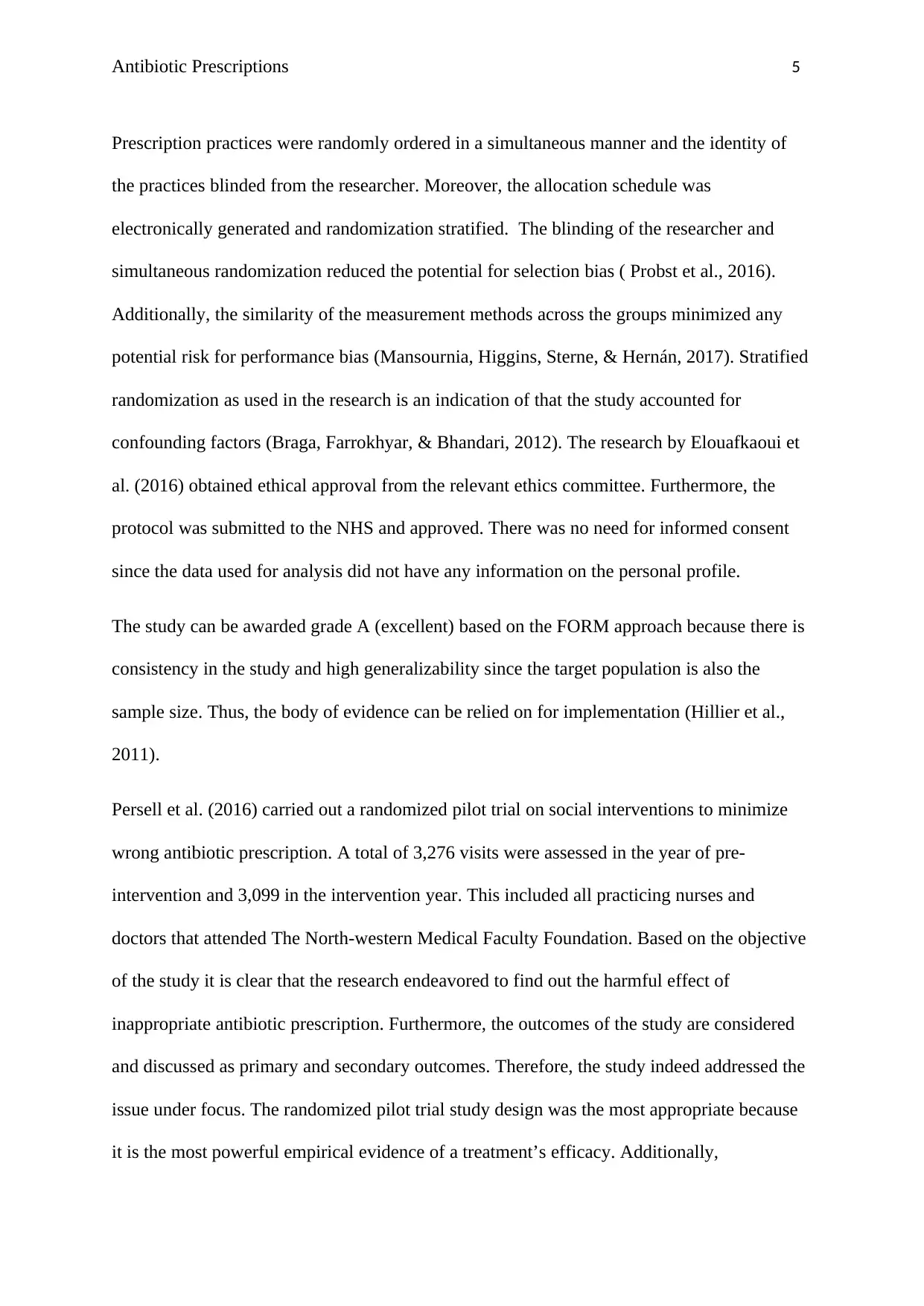
Antibiotic Prescriptions 5
Prescription practices were randomly ordered in a simultaneous manner and the identity of
the practices blinded from the researcher. Moreover, the allocation schedule was
electronically generated and randomization stratified. The blinding of the researcher and
simultaneous randomization reduced the potential for selection bias ( Probst et al., 2016).
Additionally, the similarity of the measurement methods across the groups minimized any
potential risk for performance bias (Mansournia, Higgins, Sterne, & Hernán, 2017). Stratified
randomization as used in the research is an indication of that the study accounted for
confounding factors (Braga, Farrokhyar, & Bhandari, 2012). The research by Elouafkaoui et
al. (2016) obtained ethical approval from the relevant ethics committee. Furthermore, the
protocol was submitted to the NHS and approved. There was no need for informed consent
since the data used for analysis did not have any information on the personal profile.
The study can be awarded grade A (excellent) based on the FORM approach because there is
consistency in the study and high generalizability since the target population is also the
sample size. Thus, the body of evidence can be relied on for implementation (Hillier et al.,
2011).
Persell et al. (2016) carried out a randomized pilot trial on social interventions to minimize
wrong antibiotic prescription. A total of 3,276 visits were assessed in the year of pre-
intervention and 3,099 in the intervention year. This included all practicing nurses and
doctors that attended The North-western Medical Faculty Foundation. Based on the objective
of the study it is clear that the research endeavored to find out the harmful effect of
inappropriate antibiotic prescription. Furthermore, the outcomes of the study are considered
and discussed as primary and secondary outcomes. Therefore, the study indeed addressed the
issue under focus. The randomized pilot trial study design was the most appropriate because
it is the most powerful empirical evidence of a treatment’s efficacy. Additionally,
Prescription practices were randomly ordered in a simultaneous manner and the identity of
the practices blinded from the researcher. Moreover, the allocation schedule was
electronically generated and randomization stratified. The blinding of the researcher and
simultaneous randomization reduced the potential for selection bias ( Probst et al., 2016).
Additionally, the similarity of the measurement methods across the groups minimized any
potential risk for performance bias (Mansournia, Higgins, Sterne, & Hernán, 2017). Stratified
randomization as used in the research is an indication of that the study accounted for
confounding factors (Braga, Farrokhyar, & Bhandari, 2012). The research by Elouafkaoui et
al. (2016) obtained ethical approval from the relevant ethics committee. Furthermore, the
protocol was submitted to the NHS and approved. There was no need for informed consent
since the data used for analysis did not have any information on the personal profile.
The study can be awarded grade A (excellent) based on the FORM approach because there is
consistency in the study and high generalizability since the target population is also the
sample size. Thus, the body of evidence can be relied on for implementation (Hillier et al.,
2011).
Persell et al. (2016) carried out a randomized pilot trial on social interventions to minimize
wrong antibiotic prescription. A total of 3,276 visits were assessed in the year of pre-
intervention and 3,099 in the intervention year. This included all practicing nurses and
doctors that attended The North-western Medical Faculty Foundation. Based on the objective
of the study it is clear that the research endeavored to find out the harmful effect of
inappropriate antibiotic prescription. Furthermore, the outcomes of the study are considered
and discussed as primary and secondary outcomes. Therefore, the study indeed addressed the
issue under focus. The randomized pilot trial study design was the most appropriate because
it is the most powerful empirical evidence of a treatment’s efficacy. Additionally,
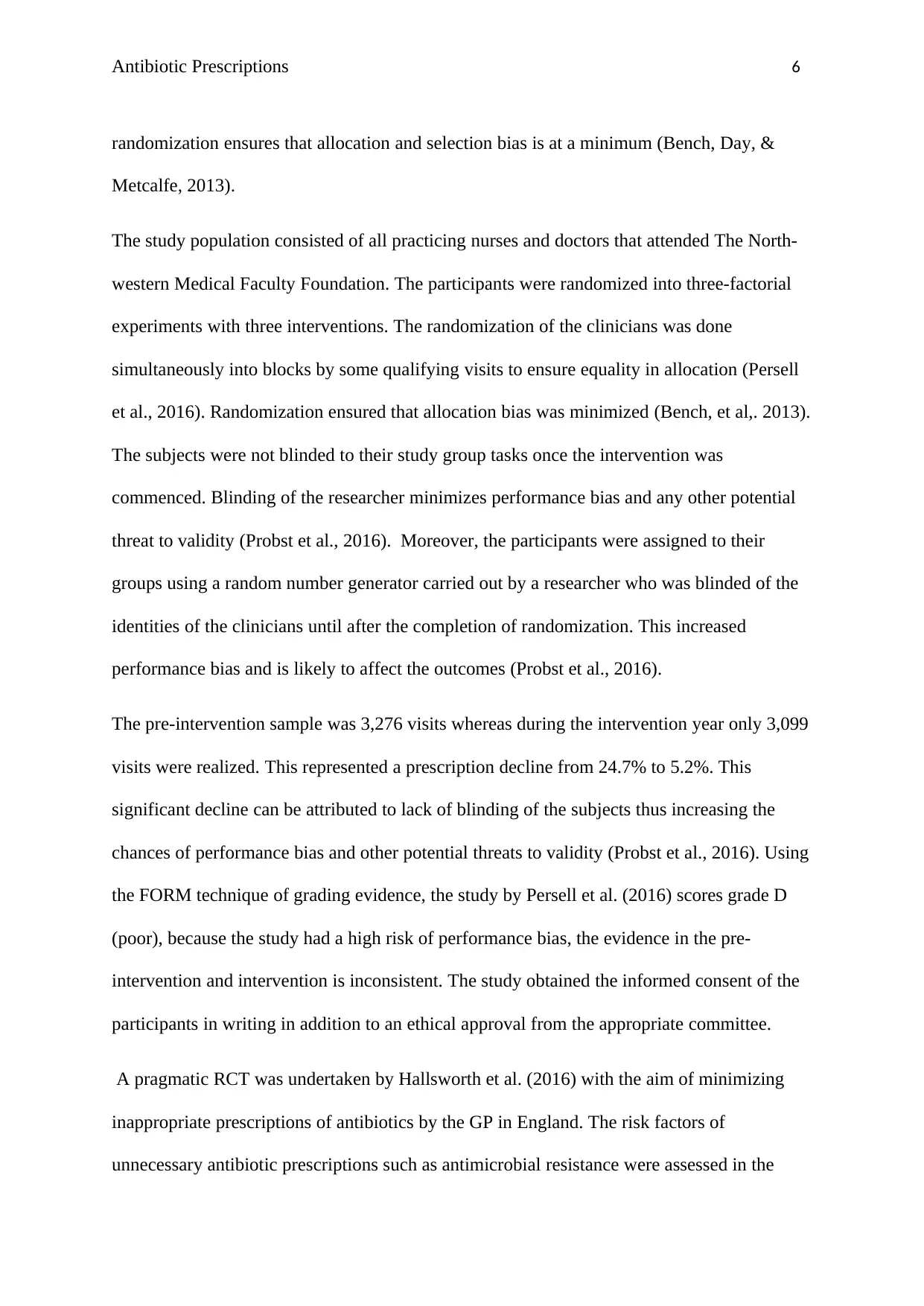
Antibiotic Prescriptions 6
randomization ensures that allocation and selection bias is at a minimum (Bench, Day, &
Metcalfe, 2013).
The study population consisted of all practicing nurses and doctors that attended The North-
western Medical Faculty Foundation. The participants were randomized into three-factorial
experiments with three interventions. The randomization of the clinicians was done
simultaneously into blocks by some qualifying visits to ensure equality in allocation (Persell
et al., 2016). Randomization ensured that allocation bias was minimized (Bench, et al,. 2013).
The subjects were not blinded to their study group tasks once the intervention was
commenced. Blinding of the researcher minimizes performance bias and any other potential
threat to validity (Probst et al., 2016). Moreover, the participants were assigned to their
groups using a random number generator carried out by a researcher who was blinded of the
identities of the clinicians until after the completion of randomization. This increased
performance bias and is likely to affect the outcomes (Probst et al., 2016).
The pre-intervention sample was 3,276 visits whereas during the intervention year only 3,099
visits were realized. This represented a prescription decline from 24.7% to 5.2%. This
significant decline can be attributed to lack of blinding of the subjects thus increasing the
chances of performance bias and other potential threats to validity (Probst et al., 2016). Using
the FORM technique of grading evidence, the study by Persell et al. (2016) scores grade D
(poor), because the study had a high risk of performance bias, the evidence in the pre-
intervention and intervention is inconsistent. The study obtained the informed consent of the
participants in writing in addition to an ethical approval from the appropriate committee.
A pragmatic RCT was undertaken by Hallsworth et al. (2016) with the aim of minimizing
inappropriate prescriptions of antibiotics by the GP in England. The risk factors of
unnecessary antibiotic prescriptions such as antimicrobial resistance were assessed in the
randomization ensures that allocation and selection bias is at a minimum (Bench, Day, &
Metcalfe, 2013).
The study population consisted of all practicing nurses and doctors that attended The North-
western Medical Faculty Foundation. The participants were randomized into three-factorial
experiments with three interventions. The randomization of the clinicians was done
simultaneously into blocks by some qualifying visits to ensure equality in allocation (Persell
et al., 2016). Randomization ensured that allocation bias was minimized (Bench, et al,. 2013).
The subjects were not blinded to their study group tasks once the intervention was
commenced. Blinding of the researcher minimizes performance bias and any other potential
threat to validity (Probst et al., 2016). Moreover, the participants were assigned to their
groups using a random number generator carried out by a researcher who was blinded of the
identities of the clinicians until after the completion of randomization. This increased
performance bias and is likely to affect the outcomes (Probst et al., 2016).
The pre-intervention sample was 3,276 visits whereas during the intervention year only 3,099
visits were realized. This represented a prescription decline from 24.7% to 5.2%. This
significant decline can be attributed to lack of blinding of the subjects thus increasing the
chances of performance bias and other potential threats to validity (Probst et al., 2016). Using
the FORM technique of grading evidence, the study by Persell et al. (2016) scores grade D
(poor), because the study had a high risk of performance bias, the evidence in the pre-
intervention and intervention is inconsistent. The study obtained the informed consent of the
participants in writing in addition to an ethical approval from the appropriate committee.
A pragmatic RCT was undertaken by Hallsworth et al. (2016) with the aim of minimizing
inappropriate prescriptions of antibiotics by the GP in England. The risk factors of
unnecessary antibiotic prescriptions such as antimicrobial resistance were assessed in the
⊘ This is a preview!⊘
Do you want full access?
Subscribe today to unlock all pages.

Trusted by 1+ million students worldwide
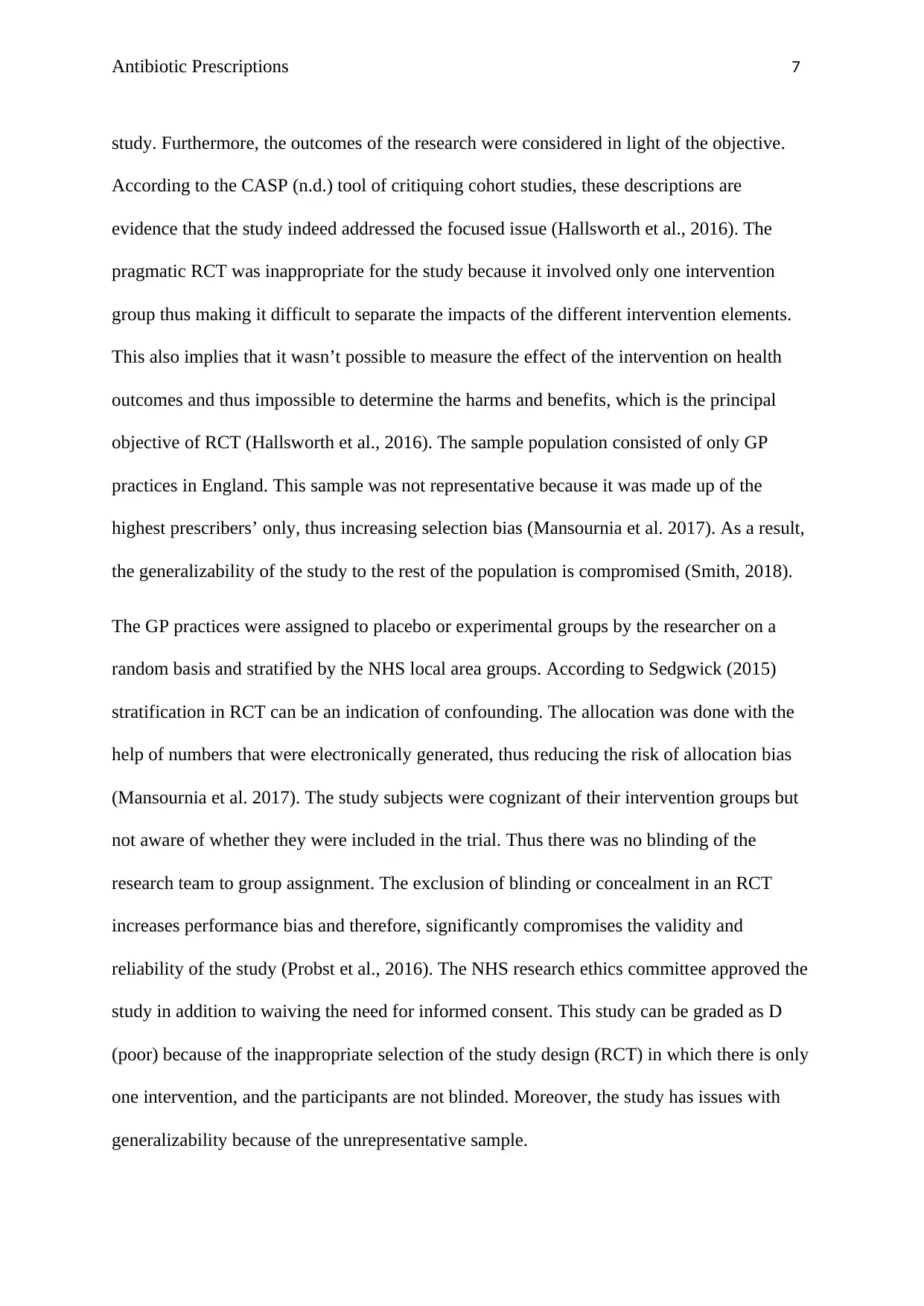
Antibiotic Prescriptions 7
study. Furthermore, the outcomes of the research were considered in light of the objective.
According to the CASP (n.d.) tool of critiquing cohort studies, these descriptions are
evidence that the study indeed addressed the focused issue (Hallsworth et al., 2016). The
pragmatic RCT was inappropriate for the study because it involved only one intervention
group thus making it difficult to separate the impacts of the different intervention elements.
This also implies that it wasn’t possible to measure the effect of the intervention on health
outcomes and thus impossible to determine the harms and benefits, which is the principal
objective of RCT (Hallsworth et al., 2016). The sample population consisted of only GP
practices in England. This sample was not representative because it was made up of the
highest prescribers’ only, thus increasing selection bias (Mansournia et al. 2017). As a result,
the generalizability of the study to the rest of the population is compromised (Smith, 2018).
The GP practices were assigned to placebo or experimental groups by the researcher on a
random basis and stratified by the NHS local area groups. According to Sedgwick (2015)
stratification in RCT can be an indication of confounding. The allocation was done with the
help of numbers that were electronically generated, thus reducing the risk of allocation bias
(Mansournia et al. 2017). The study subjects were cognizant of their intervention groups but
not aware of whether they were included in the trial. Thus there was no blinding of the
research team to group assignment. The exclusion of blinding or concealment in an RCT
increases performance bias and therefore, significantly compromises the validity and
reliability of the study (Probst et al., 2016). The NHS research ethics committee approved the
study in addition to waiving the need for informed consent. This study can be graded as D
(poor) because of the inappropriate selection of the study design (RCT) in which there is only
one intervention, and the participants are not blinded. Moreover, the study has issues with
generalizability because of the unrepresentative sample.
study. Furthermore, the outcomes of the research were considered in light of the objective.
According to the CASP (n.d.) tool of critiquing cohort studies, these descriptions are
evidence that the study indeed addressed the focused issue (Hallsworth et al., 2016). The
pragmatic RCT was inappropriate for the study because it involved only one intervention
group thus making it difficult to separate the impacts of the different intervention elements.
This also implies that it wasn’t possible to measure the effect of the intervention on health
outcomes and thus impossible to determine the harms and benefits, which is the principal
objective of RCT (Hallsworth et al., 2016). The sample population consisted of only GP
practices in England. This sample was not representative because it was made up of the
highest prescribers’ only, thus increasing selection bias (Mansournia et al. 2017). As a result,
the generalizability of the study to the rest of the population is compromised (Smith, 2018).
The GP practices were assigned to placebo or experimental groups by the researcher on a
random basis and stratified by the NHS local area groups. According to Sedgwick (2015)
stratification in RCT can be an indication of confounding. The allocation was done with the
help of numbers that were electronically generated, thus reducing the risk of allocation bias
(Mansournia et al. 2017). The study subjects were cognizant of their intervention groups but
not aware of whether they were included in the trial. Thus there was no blinding of the
research team to group assignment. The exclusion of blinding or concealment in an RCT
increases performance bias and therefore, significantly compromises the validity and
reliability of the study (Probst et al., 2016). The NHS research ethics committee approved the
study in addition to waiving the need for informed consent. This study can be graded as D
(poor) because of the inappropriate selection of the study design (RCT) in which there is only
one intervention, and the participants are not blinded. Moreover, the study has issues with
generalizability because of the unrepresentative sample.
Paraphrase This Document
Need a fresh take? Get an instant paraphrase of this document with our AI Paraphraser
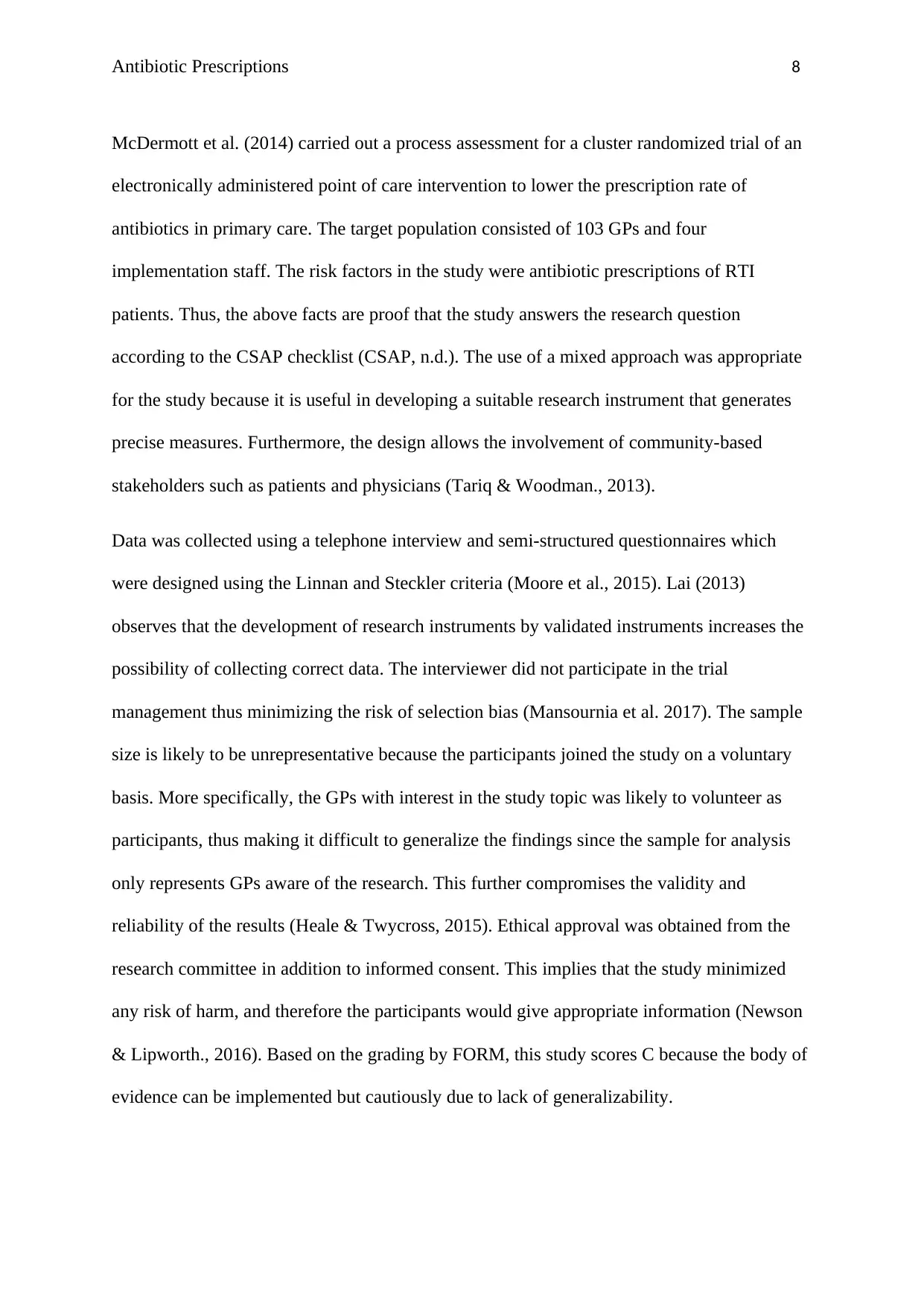
Antibiotic Prescriptions 8
McDermott et al. (2014) carried out a process assessment for a cluster randomized trial of an
electronically administered point of care intervention to lower the prescription rate of
antibiotics in primary care. The target population consisted of 103 GPs and four
implementation staff. The risk factors in the study were antibiotic prescriptions of RTI
patients. Thus, the above facts are proof that the study answers the research question
according to the CSAP checklist (CSAP, n.d.). The use of a mixed approach was appropriate
for the study because it is useful in developing a suitable research instrument that generates
precise measures. Furthermore, the design allows the involvement of community-based
stakeholders such as patients and physicians (Tariq & Woodman., 2013).
Data was collected using a telephone interview and semi-structured questionnaires which
were designed using the Linnan and Steckler criteria (Moore et al., 2015). Lai (2013)
observes that the development of research instruments by validated instruments increases the
possibility of collecting correct data. The interviewer did not participate in the trial
management thus minimizing the risk of selection bias (Mansournia et al. 2017). The sample
size is likely to be unrepresentative because the participants joined the study on a voluntary
basis. More specifically, the GPs with interest in the study topic was likely to volunteer as
participants, thus making it difficult to generalize the findings since the sample for analysis
only represents GPs aware of the research. This further compromises the validity and
reliability of the results (Heale & Twycross, 2015). Ethical approval was obtained from the
research committee in addition to informed consent. This implies that the study minimized
any risk of harm, and therefore the participants would give appropriate information (Newson
& Lipworth., 2016). Based on the grading by FORM, this study scores C because the body of
evidence can be implemented but cautiously due to lack of generalizability.
McDermott et al. (2014) carried out a process assessment for a cluster randomized trial of an
electronically administered point of care intervention to lower the prescription rate of
antibiotics in primary care. The target population consisted of 103 GPs and four
implementation staff. The risk factors in the study were antibiotic prescriptions of RTI
patients. Thus, the above facts are proof that the study answers the research question
according to the CSAP checklist (CSAP, n.d.). The use of a mixed approach was appropriate
for the study because it is useful in developing a suitable research instrument that generates
precise measures. Furthermore, the design allows the involvement of community-based
stakeholders such as patients and physicians (Tariq & Woodman., 2013).
Data was collected using a telephone interview and semi-structured questionnaires which
were designed using the Linnan and Steckler criteria (Moore et al., 2015). Lai (2013)
observes that the development of research instruments by validated instruments increases the
possibility of collecting correct data. The interviewer did not participate in the trial
management thus minimizing the risk of selection bias (Mansournia et al. 2017). The sample
size is likely to be unrepresentative because the participants joined the study on a voluntary
basis. More specifically, the GPs with interest in the study topic was likely to volunteer as
participants, thus making it difficult to generalize the findings since the sample for analysis
only represents GPs aware of the research. This further compromises the validity and
reliability of the results (Heale & Twycross, 2015). Ethical approval was obtained from the
research committee in addition to informed consent. This implies that the study minimized
any risk of harm, and therefore the participants would give appropriate information (Newson
& Lipworth., 2016). Based on the grading by FORM, this study scores C because the body of
evidence can be implemented but cautiously due to lack of generalizability.
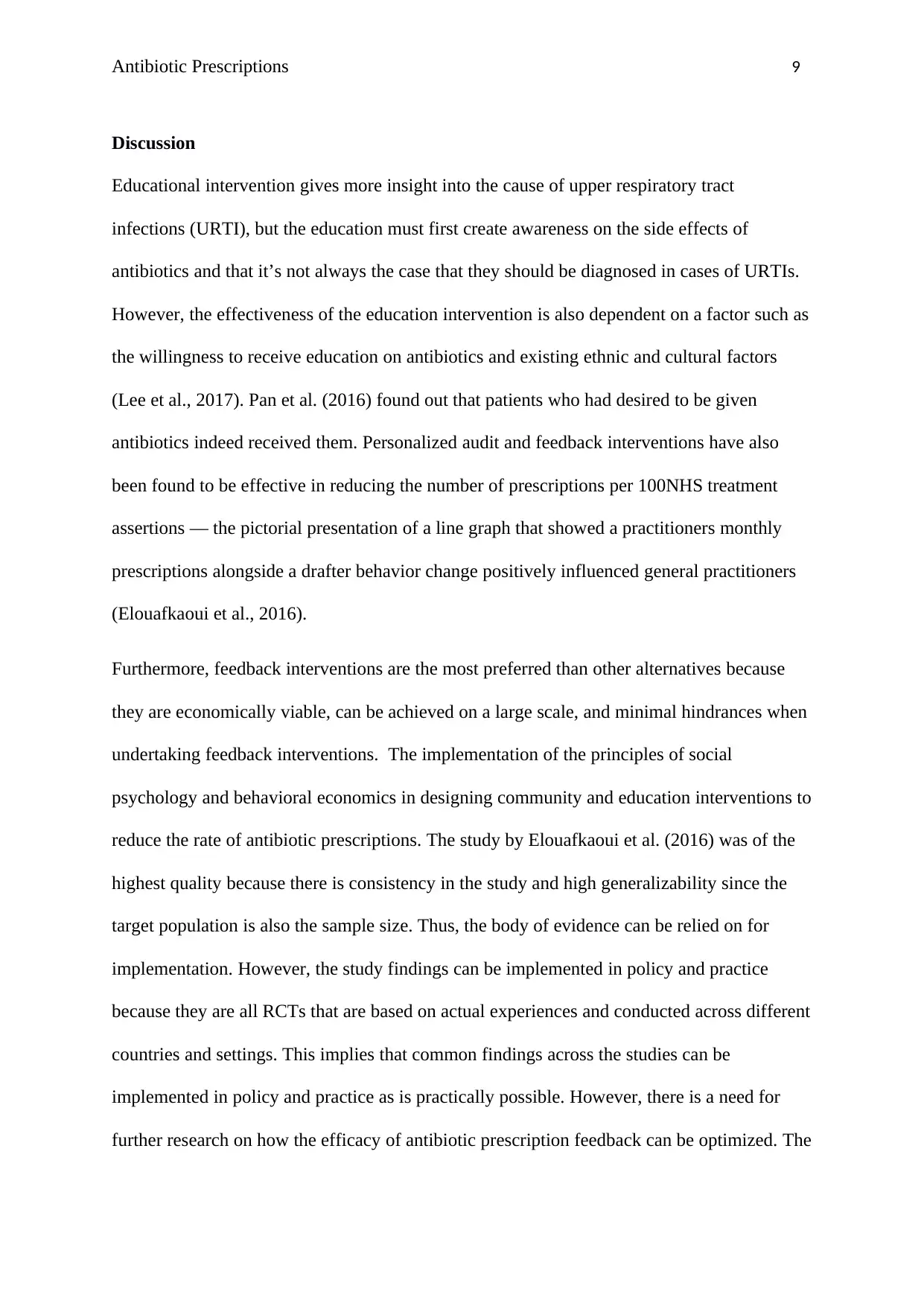
Antibiotic Prescriptions 9
Discussion
Educational intervention gives more insight into the cause of upper respiratory tract
infections (URTI), but the education must first create awareness on the side effects of
antibiotics and that it’s not always the case that they should be diagnosed in cases of URTIs.
However, the effectiveness of the education intervention is also dependent on a factor such as
the willingness to receive education on antibiotics and existing ethnic and cultural factors
(Lee et al., 2017). Pan et al. (2016) found out that patients who had desired to be given
antibiotics indeed received them. Personalized audit and feedback interventions have also
been found to be effective in reducing the number of prescriptions per 100NHS treatment
assertions — the pictorial presentation of a line graph that showed a practitioners monthly
prescriptions alongside a drafter behavior change positively influenced general practitioners
(Elouafkaoui et al., 2016).
Furthermore, feedback interventions are the most preferred than other alternatives because
they are economically viable, can be achieved on a large scale, and minimal hindrances when
undertaking feedback interventions. The implementation of the principles of social
psychology and behavioral economics in designing community and education interventions to
reduce the rate of antibiotic prescriptions. The study by Elouafkaoui et al. (2016) was of the
highest quality because there is consistency in the study and high generalizability since the
target population is also the sample size. Thus, the body of evidence can be relied on for
implementation. However, the study findings can be implemented in policy and practice
because they are all RCTs that are based on actual experiences and conducted across different
countries and settings. This implies that common findings across the studies can be
implemented in policy and practice as is practically possible. However, there is a need for
further research on how the efficacy of antibiotic prescription feedback can be optimized. The
Discussion
Educational intervention gives more insight into the cause of upper respiratory tract
infections (URTI), but the education must first create awareness on the side effects of
antibiotics and that it’s not always the case that they should be diagnosed in cases of URTIs.
However, the effectiveness of the education intervention is also dependent on a factor such as
the willingness to receive education on antibiotics and existing ethnic and cultural factors
(Lee et al., 2017). Pan et al. (2016) found out that patients who had desired to be given
antibiotics indeed received them. Personalized audit and feedback interventions have also
been found to be effective in reducing the number of prescriptions per 100NHS treatment
assertions — the pictorial presentation of a line graph that showed a practitioners monthly
prescriptions alongside a drafter behavior change positively influenced general practitioners
(Elouafkaoui et al., 2016).
Furthermore, feedback interventions are the most preferred than other alternatives because
they are economically viable, can be achieved on a large scale, and minimal hindrances when
undertaking feedback interventions. The implementation of the principles of social
psychology and behavioral economics in designing community and education interventions to
reduce the rate of antibiotic prescriptions. The study by Elouafkaoui et al. (2016) was of the
highest quality because there is consistency in the study and high generalizability since the
target population is also the sample size. Thus, the body of evidence can be relied on for
implementation. However, the study findings can be implemented in policy and practice
because they are all RCTs that are based on actual experiences and conducted across different
countries and settings. This implies that common findings across the studies can be
implemented in policy and practice as is practically possible. However, there is a need for
further research on how the efficacy of antibiotic prescription feedback can be optimized. The
⊘ This is a preview!⊘
Do you want full access?
Subscribe today to unlock all pages.

Trusted by 1+ million students worldwide
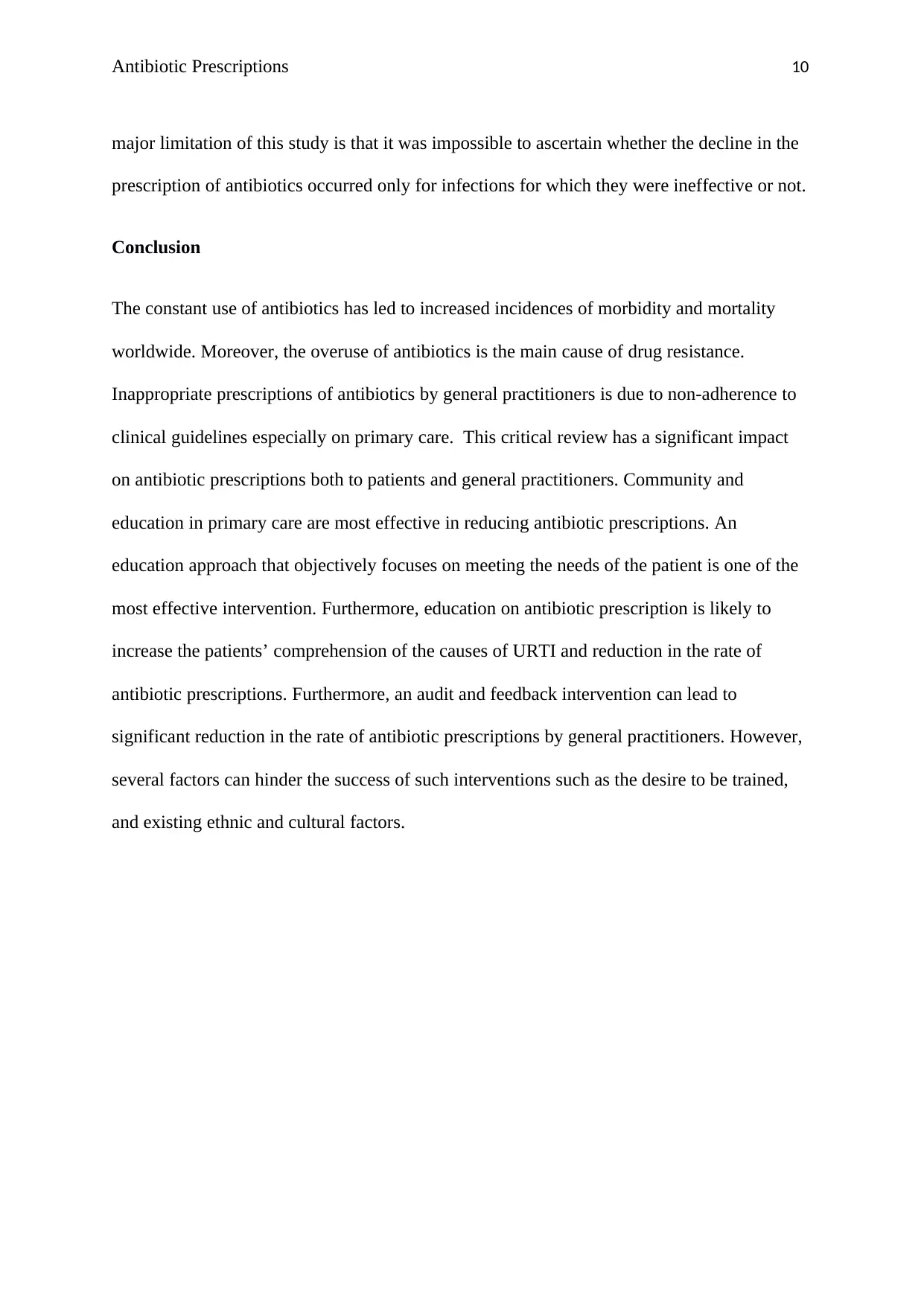
Antibiotic Prescriptions 10
major limitation of this study is that it was impossible to ascertain whether the decline in the
prescription of antibiotics occurred only for infections for which they were ineffective or not.
Conclusion
The constant use of antibiotics has led to increased incidences of morbidity and mortality
worldwide. Moreover, the overuse of antibiotics is the main cause of drug resistance.
Inappropriate prescriptions of antibiotics by general practitioners is due to non-adherence to
clinical guidelines especially on primary care. This critical review has a significant impact
on antibiotic prescriptions both to patients and general practitioners. Community and
education in primary care are most effective in reducing antibiotic prescriptions. An
education approach that objectively focuses on meeting the needs of the patient is one of the
most effective intervention. Furthermore, education on antibiotic prescription is likely to
increase the patients’ comprehension of the causes of URTI and reduction in the rate of
antibiotic prescriptions. Furthermore, an audit and feedback intervention can lead to
significant reduction in the rate of antibiotic prescriptions by general practitioners. However,
several factors can hinder the success of such interventions such as the desire to be trained,
and existing ethnic and cultural factors.
major limitation of this study is that it was impossible to ascertain whether the decline in the
prescription of antibiotics occurred only for infections for which they were ineffective or not.
Conclusion
The constant use of antibiotics has led to increased incidences of morbidity and mortality
worldwide. Moreover, the overuse of antibiotics is the main cause of drug resistance.
Inappropriate prescriptions of antibiotics by general practitioners is due to non-adherence to
clinical guidelines especially on primary care. This critical review has a significant impact
on antibiotic prescriptions both to patients and general practitioners. Community and
education in primary care are most effective in reducing antibiotic prescriptions. An
education approach that objectively focuses on meeting the needs of the patient is one of the
most effective intervention. Furthermore, education on antibiotic prescription is likely to
increase the patients’ comprehension of the causes of URTI and reduction in the rate of
antibiotic prescriptions. Furthermore, an audit and feedback intervention can lead to
significant reduction in the rate of antibiotic prescriptions by general practitioners. However,
several factors can hinder the success of such interventions such as the desire to be trained,
and existing ethnic and cultural factors.
Paraphrase This Document
Need a fresh take? Get an instant paraphrase of this document with our AI Paraphraser
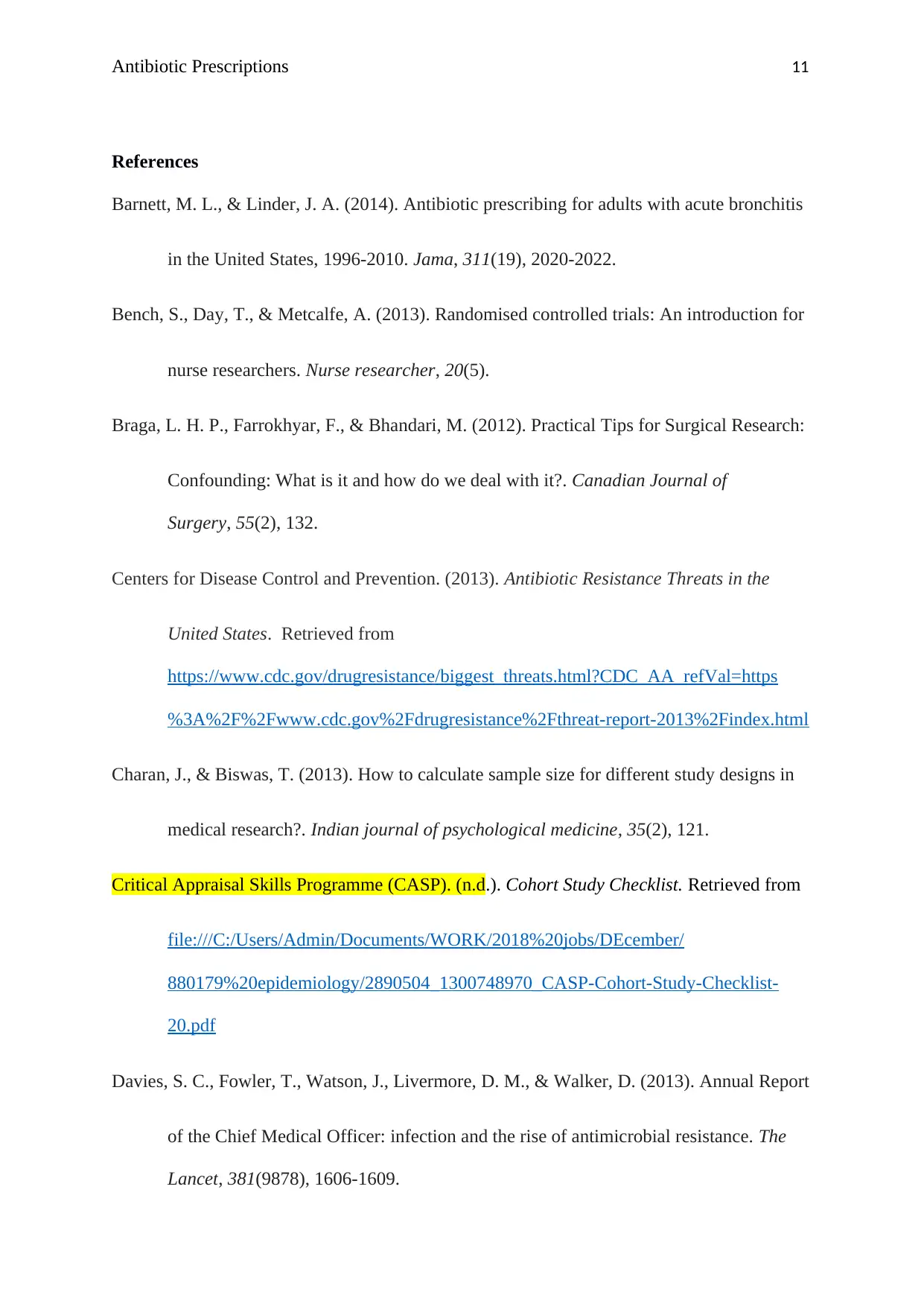
Antibiotic Prescriptions 11
References
Barnett, M. L., & Linder, J. A. (2014). Antibiotic prescribing for adults with acute bronchitis
in the United States, 1996-2010. Jama, 311(19), 2020-2022.
Bench, S., Day, T., & Metcalfe, A. (2013). Randomised controlled trials: An introduction for
nurse researchers. Nurse researcher, 20(5).
Braga, L. H. P., Farrokhyar, F., & Bhandari, M. (2012). Practical Tips for Surgical Research:
Confounding: What is it and how do we deal with it?. Canadian Journal of
Surgery, 55(2), 132.
Centers for Disease Control and Prevention. (2013). Antibiotic Resistance Threats in the
United States. Retrieved from
https://www.cdc.gov/drugresistance/biggest_threats.html?CDC_AA_refVal=https
%3A%2F%2Fwww.cdc.gov%2Fdrugresistance%2Fthreat-report-2013%2Findex.html
Charan, J., & Biswas, T. (2013). How to calculate sample size for different study designs in
medical research?. Indian journal of psychological medicine, 35(2), 121.
Critical Appraisal Skills Programme (CASP). (n.d.). Cohort Study Checklist. Retrieved from
file:///C:/Users/Admin/Documents/WORK/2018%20jobs/DEcember/
880179%20epidemiology/2890504_1300748970_CASP-Cohort-Study-Checklist-
20.pdf
Davies, S. C., Fowler, T., Watson, J., Livermore, D. M., & Walker, D. (2013). Annual Report
of the Chief Medical Officer: infection and the rise of antimicrobial resistance. The
Lancet, 381(9878), 1606-1609.
References
Barnett, M. L., & Linder, J. A. (2014). Antibiotic prescribing for adults with acute bronchitis
in the United States, 1996-2010. Jama, 311(19), 2020-2022.
Bench, S., Day, T., & Metcalfe, A. (2013). Randomised controlled trials: An introduction for
nurse researchers. Nurse researcher, 20(5).
Braga, L. H. P., Farrokhyar, F., & Bhandari, M. (2012). Practical Tips for Surgical Research:
Confounding: What is it and how do we deal with it?. Canadian Journal of
Surgery, 55(2), 132.
Centers for Disease Control and Prevention. (2013). Antibiotic Resistance Threats in the
United States. Retrieved from
https://www.cdc.gov/drugresistance/biggest_threats.html?CDC_AA_refVal=https
%3A%2F%2Fwww.cdc.gov%2Fdrugresistance%2Fthreat-report-2013%2Findex.html
Charan, J., & Biswas, T. (2013). How to calculate sample size for different study designs in
medical research?. Indian journal of psychological medicine, 35(2), 121.
Critical Appraisal Skills Programme (CASP). (n.d.). Cohort Study Checklist. Retrieved from
file:///C:/Users/Admin/Documents/WORK/2018%20jobs/DEcember/
880179%20epidemiology/2890504_1300748970_CASP-Cohort-Study-Checklist-
20.pdf
Davies, S. C., Fowler, T., Watson, J., Livermore, D. M., & Walker, D. (2013). Annual Report
of the Chief Medical Officer: infection and the rise of antimicrobial resistance. The
Lancet, 381(9878), 1606-1609.
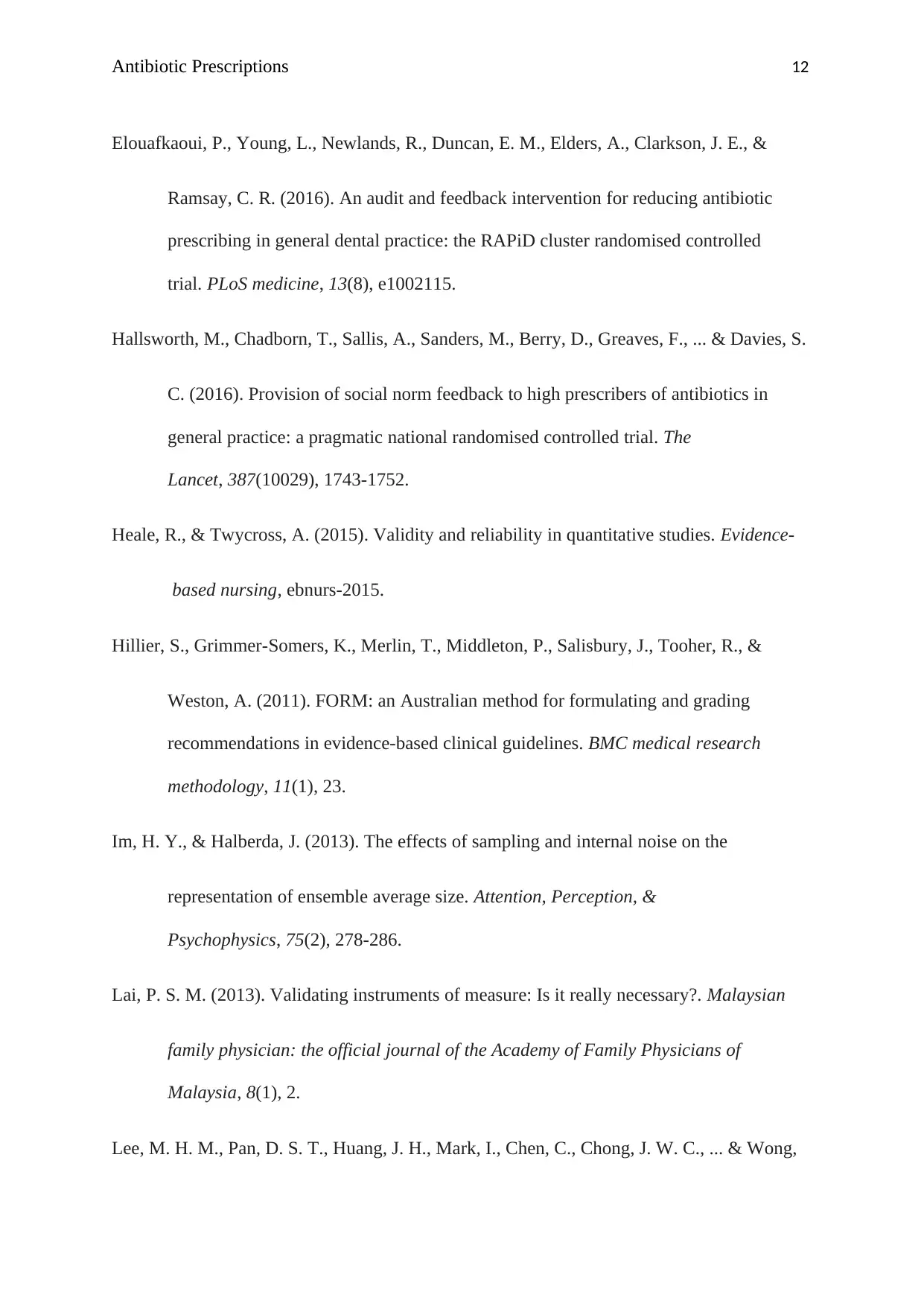
Antibiotic Prescriptions 12
Elouafkaoui, P., Young, L., Newlands, R., Duncan, E. M., Elders, A., Clarkson, J. E., &
Ramsay, C. R. (2016). An audit and feedback intervention for reducing antibiotic
prescribing in general dental practice: the RAPiD cluster randomised controlled
trial. PLoS medicine, 13(8), e1002115.
Hallsworth, M., Chadborn, T., Sallis, A., Sanders, M., Berry, D., Greaves, F., ... & Davies, S.
C. (2016). Provision of social norm feedback to high prescribers of antibiotics in
general practice: a pragmatic national randomised controlled trial. The
Lancet, 387(10029), 1743-1752.
Heale, R., & Twycross, A. (2015). Validity and reliability in quantitative studies. Evidence-
based nursing, ebnurs-2015.
Hillier, S., Grimmer-Somers, K., Merlin, T., Middleton, P., Salisbury, J., Tooher, R., &
Weston, A. (2011). FORM: an Australian method for formulating and grading
recommendations in evidence-based clinical guidelines. BMC medical research
methodology, 11(1), 23.
Im, H. Y., & Halberda, J. (2013). The effects of sampling and internal noise on the
representation of ensemble average size. Attention, Perception, &
Psychophysics, 75(2), 278-286.
Lai, P. S. M. (2013). Validating instruments of measure: Is it really necessary?. Malaysian
family physician: the official journal of the Academy of Family Physicians of
Malaysia, 8(1), 2.
Lee, M. H. M., Pan, D. S. T., Huang, J. H., Mark, I., Chen, C., Chong, J. W. C., ... & Wong,
Elouafkaoui, P., Young, L., Newlands, R., Duncan, E. M., Elders, A., Clarkson, J. E., &
Ramsay, C. R. (2016). An audit and feedback intervention for reducing antibiotic
prescribing in general dental practice: the RAPiD cluster randomised controlled
trial. PLoS medicine, 13(8), e1002115.
Hallsworth, M., Chadborn, T., Sallis, A., Sanders, M., Berry, D., Greaves, F., ... & Davies, S.
C. (2016). Provision of social norm feedback to high prescribers of antibiotics in
general practice: a pragmatic national randomised controlled trial. The
Lancet, 387(10029), 1743-1752.
Heale, R., & Twycross, A. (2015). Validity and reliability in quantitative studies. Evidence-
based nursing, ebnurs-2015.
Hillier, S., Grimmer-Somers, K., Merlin, T., Middleton, P., Salisbury, J., Tooher, R., &
Weston, A. (2011). FORM: an Australian method for formulating and grading
recommendations in evidence-based clinical guidelines. BMC medical research
methodology, 11(1), 23.
Im, H. Y., & Halberda, J. (2013). The effects of sampling and internal noise on the
representation of ensemble average size. Attention, Perception, &
Psychophysics, 75(2), 278-286.
Lai, P. S. M. (2013). Validating instruments of measure: Is it really necessary?. Malaysian
family physician: the official journal of the Academy of Family Physicians of
Malaysia, 8(1), 2.
Lee, M. H. M., Pan, D. S. T., Huang, J. H., Mark, I., Chen, C., Chong, J. W. C., ... & Wong,
⊘ This is a preview!⊘
Do you want full access?
Subscribe today to unlock all pages.

Trusted by 1+ million students worldwide
1 out of 15
Related Documents
Your All-in-One AI-Powered Toolkit for Academic Success.
+13062052269
info@desklib.com
Available 24*7 on WhatsApp / Email
![[object Object]](/_next/static/media/star-bottom.7253800d.svg)
Unlock your academic potential
Copyright © 2020–2025 A2Z Services. All Rights Reserved. Developed and managed by ZUCOL.





